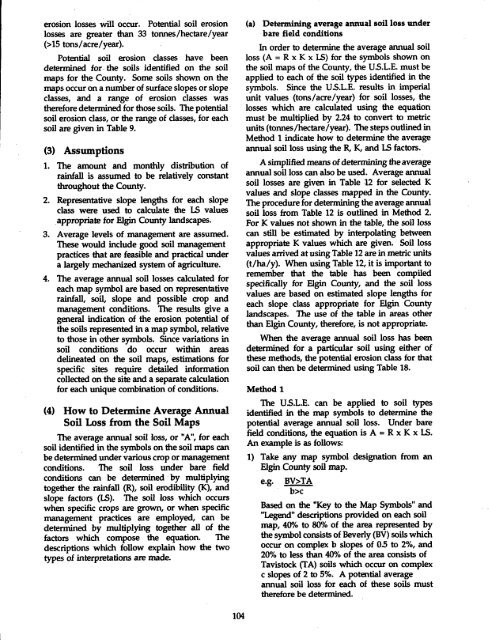The Soils of Elgin County - Agriculture and Agri-Food Canada
The Soils of Elgin County - Agriculture and Agri-Food Canada
The Soils of Elgin County - Agriculture and Agri-Food Canada
- No tags were found...
You also want an ePaper? Increase the reach of your titles
YUMPU automatically turns print PDFs into web optimized ePapers that Google loves.
erosion losses will occur . Potential soil erosionlosses are greater than 33 tonnes/hectare/year(>15 tons/acre/year) .Potential soil erosion classes have beendetermined for the soils identified on the soilmaps for the <strong>County</strong> . Some soils shown on themaps occur on a number <strong>of</strong> surface slopes or slopeclasses, <strong>and</strong> a range <strong>of</strong> erosion classes wastherefore determined for those soils . <strong>The</strong> potentialsoil erosion class, or the range <strong>of</strong> classes, for eachsoil are given in Table 9.(3) Assumptions1 . <strong>The</strong> amount <strong>and</strong> monthly distribution <strong>of</strong>rainfall is assumed to be relatively constantthroughout the <strong>County</strong>.2. Representative slope lengths for each slopeclass were used to calculate the LS valuesappropriate for <strong>Elgin</strong> <strong>County</strong> l<strong>and</strong>scapes .3. Average levels <strong>of</strong> . management are assumed .<strong>The</strong>se would include good soil managementpractices that are feasible <strong>and</strong> practical undera largely mechanized system <strong>of</strong> agriculture.4 . <strong>The</strong> average annual soil losses calculated foreach map symbol are based on representativerainfall, soil, slope <strong>and</strong> possible crop <strong>and</strong>management conditions . <strong>The</strong> results give ageneral indication <strong>of</strong> the erosion potential <strong>of</strong>the soils represented in a map symbol, relativeto those in other symbols. Since variations insoil conditions do occur within areasdelineated on the soil maps, estimations forspecific sites require detailed informationcollected on the site <strong>and</strong>a separate calculationfor each unique combination <strong>of</strong> conditions .(4) How to Determine Average AnnualSoil Loss from the Soil Maps<strong>The</strong> average annual soil loss, or "A", for eachsoil identified in the symbols on the soil maps canbe determined under various crop or managementconditions . <strong>The</strong> soil loss under bare fieldconditions can be determined by multiplyingtogether the rainfall (R), soil erodibility (K), <strong>and</strong>slope factors (LS). <strong>The</strong> soil loss which occurswhen specific crops are grown, or when specificmanagement practices are employed, can bedetermined by multiplying together all <strong>of</strong> thefactors which compose the equation. <strong>The</strong>descriptions which follow explain how the twotypes <strong>of</strong> interpretations are made.(a)Determining average annual soil loss underbare field conditionsIn order to determine the average annual soilloss (A = R x K x LS) for the symbols shown onthe soil maps <strong>of</strong> the <strong>County</strong>, the U.S .L .E. must beapplied to each <strong>of</strong> the soil types identified in thesymbols. Since the U.S.L .E. results in imperialunit values (tons/acre/year) for soil losses, thelosses which are calculated using the equationmust be multiplied by 2.24 to convert to metricunits (tonnes/hectare/year) . <strong>The</strong> steps outlined inMethod 1 indicate how to determine the averageannual soil loss using the R, K, <strong>and</strong> LS factors.A simplified means <strong>of</strong> determining theaverageannual soil loss can also be used . Average annualsoil losses are given in Table 12 for selected Kvalues <strong>and</strong> slope classes mapped in the <strong>County</strong> .<strong>The</strong> procedure for determining the average annualsoil loss from Table 12 is outlined in Method 2.For K values not shown in the table, the soil losscan still be estimated by interpolating betweenappropriate K values which are given . Soil lossvalues arrived at usingTable 12 are in metric units(t/ha/y). When using Table 12, it is important toremember that the table has been compiledspecifically for <strong>Elgin</strong> <strong>County</strong>, <strong>and</strong> the soil lossvalues are based on estimated slope lengths foreach slope class appropriate for <strong>Elgin</strong> <strong>County</strong>l<strong>and</strong>scapes. <strong>The</strong> use <strong>of</strong> the table in areas otherthan <strong>Elgin</strong> <strong>County</strong>, therefore, is not appropriate.When the average annual soil loss has beendetermined for a particular soil using either <strong>of</strong>these methods, the potential erosion class for thatsoil can then be determined using Table 18 .Method 1<strong>The</strong> U.S .L.E . can be applied to soil typesidentified in the map symbols to determine thepotential average annual soil loss. Under barefield conditions, the equation is A = R x K x IS.An example is as follows :1) Take any map symbol designation from an<strong>Elgin</strong> <strong>County</strong> soil map .e.g .BV>TAb>cBased on the "Key to the Map Symbols" <strong>and</strong>"Legend" descriptions provided on each soilmap, 40% to 80% <strong>of</strong> the area represented bythe symbol consists <strong>of</strong> Beverly (BV) soils whichoccur on complex b slopes <strong>of</strong> 0.5 to 2%, <strong>and</strong>20% to less than 40% <strong>of</strong> the area consists <strong>of</strong>Tavistock (TA) soils which occur on complexc slopes <strong>of</strong> 2 to 5%. A potential averageannual soil loss for each <strong>of</strong> these soils musttherefore be determined.104
















